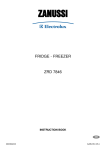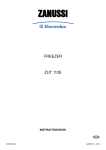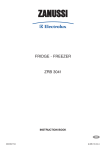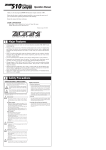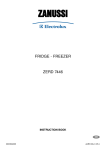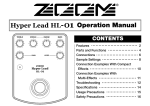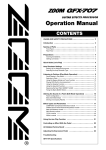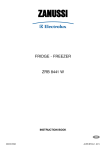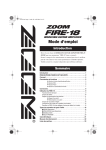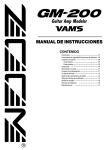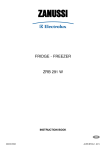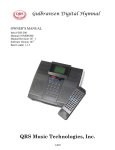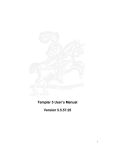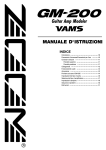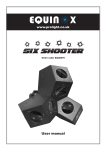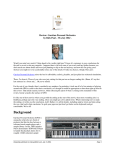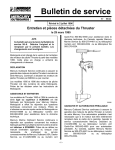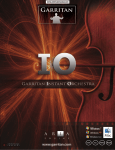Download the 509 User Manual
Transcript
Operation Manual Thank you for selecting the ZOOM 509 (hereafter simply called the "509"). Please take the time to read this manual carefully so you can get the most out of your 509 and ensure optimum performance and reliability. Retain this manual for future reference. ZOOM CORPORATION NOAH Bldg., 2-10-2, Miyanishi-cho, Fuchu-shi, Tokyo 183, Japan PHONE: 0423-69-7116 FAX: 0423-69-7115 Printed in Japan 509-5000 1 Major Features • Dedicated modulation unit with two on-board modulation modules (EFFECT 1 and EFFECT 2) for a total of 20 effects. Up to two effects can be used simultaneously, allowing versatile sound creations. • Harmonized Pitch Shifter (HPS) lets you specify a desired key and scale to create dual harmonies, a first in this price class. Do impressive guitar orchestrations with twin or triple leads using a single instrument. • You can switch between 24 patches to store diverse settings based on your preference. • Integrated auto-chromatic tuner for guitar. You can tune your instrument easily anywhere, any time. You can also leave the tuning function disabled all the time. • DETECTOR IN jack for HPS pitch detection accepts the original guitar signal, assuring reliable pitch shift action when used immediately after a distortion effect. • Optional expression pedal FP01 can be used to adjust pitch, effect mix level, output level and other parameters. Optional foot switch FS01 lets you switch EFFECT 1 on and off during a performance. • Dual power supply design allows the unit to be powered from a 9V alkaline battery (6LR61) or an AC adapter. 2 Safety Precautions USAGE AND SAFETY PRECAUTIONS In this manual, symbols are used to highlight warnings and cautions for you to read so that accidents can be prevented. The meanings of these symbols are as follows: Warning This symbol indicates explanations about extremely dangerous issues. If users ignore this symbol and handle the device incorrectly, serious injury or death could result. Caution This symbol indicates explanations about dangerous issues. If users ignore this symbol and handle the device the wrong way, bodily injury and damage to the equipment could result. Please observe the following safety tips and precautions to ensure hazard-free use of the 509. About power Warning Since power consumption of this unit is fairly high, we recommend the use of an AC adapter whenever possible. When powering the unit from a battery, use only an alkaline type. AC adapter operation • Be sure to use only an AC adapter which supplies 9 V DC, 300 mA and is equipped with a "center minus" plug (Zoom AD-0006). The use of an adapter other than the specified type may damage the unit and pose a safety hazard. • Connect the AC adapter only to an AC outlet that supplies the rated voltage required by the adapter. • When disconnecting the AC adapter from the AC outlet, always grasp the adapter itself and do not pull the cable. • If the unit is not to be used for a long time, disconnect the AC adapter from the outlet. Battery operation • Use only a 9 V (alkaline) battery (6LR61). • The 509 cannot be used for recharging. Pay close attention to the labelling of the battery to make sure you choose the correct type. • If the 509 is not to be used for an extended period of time, remove the battery from the unit. • If battery leakage has occurred, wipe the battery compartment and the battery terminals carefully to remove all remnants of battery fluid. • While using the unit, the battery compartment cover should be closed. Environment Caution • • • • Avoid using your 509 in environments where it will be exposed to: Extreme temperature High humidity or moisture Excessive dust or sand Excessive vibration or shock Handling Caution • The 509 is a precision instrument. Except for the foot switches, do not push other parts with your feet or subject them to strong force. • Take care that no foreign objects (coins or pins etc.) or liquids enter the unit. • Be sure to turn the power to all equipment off before making connections. • Before moving the unit, turn the power off and disconnect all cables and the AC adapter. Alterations Caution Never open the case of the 509 or attempt to modify the product in any way since this can result in damage to the unit. Usage precautions Electrical interference For safety considerations, the 509 has been designed to provide maximum protection against the emission of electromagnetic radiation from inside the device, and from external interference.However, equipment that is very susceptible to interference or that emits powerful electromagnetic waves should not be placed near the 509, as the possibility of interference cannot be ruled out entirely. Whatever the type of digital control device, the 509 included, electromagnetic damage can cause malfunctioning and corrupt or destroy data. Since this is an ever-present danger, thorough care should be taken to minimize the risk of damage. Cleaning Use a soft, dry cloth to clean the 509. If necessary, slightly moisten the cloth. Do not use abrasive cleanser, wax, or solvents (such as paint thinner or cleaning alcohol), since these may dull the finish or damage the surface. Connecting cables and input and output jacks You should always turn off the power to the 509 and all other equipment before connecting or disconnecting any cables. Also make sure to disconnect all cables and the AC adapter before moving the 509. 3 What Are Banks and Patches? 4 PATCH LIST The 509 has memory capacity for 24 patches. At the factory, these are programmed with recommended settings. The user can Edit and Store any patch, and also restore the factory settings. • PATCH A group of the settings for a certain effect type is called a PATCH. The 509 comes with 24 preset patches which can be changed (edited) by the user. Patch No. • BANK The 509 calls up patches in sets of four, called a "bank". BANK F BANK E BANK d BANK C BANK b BANK A PATCH 1 PATCH 2 PATCH 3 PATCH 4 PATCH 1 PATCH 2 PATCH 3 PATCH 4 PATCH 1 PATCH 2 PATCH 3 PATCH 4 PATCH 1 PATCH 2 PATCH 3 PATCH 4 PATCH 1 PATCH 2 PATCH 3 PATCH 4 PATCH 1 PATCH 2 PATCH 3 PATCH 4 Patch Name Effect Types Description A1 A2 A3 A4 Super Chorus Jet Flange C Maj HPS Deep Rotor CHORUS 1 FLANGER 1 2–VOICE HPS ROTARY – – DOUBLING 2 DOUBLING 1 – DOUBLING 1 Useful chorus effect Flanging sound to match distortion effects Harmony in C major Expansive rotary sound b1 b2 b3 b4 Natural Chorus PHASE–1000 Trendy Blue Note CHORUS 2 EQUALIZER 1 CHORUS 2 DOUBLING 2 – – – – EQUALIZER 2 PHASE 2 TREMOLO EQUALIZER 1 Traditional-type chorus Funky phase sound Modern-style tremolo Bluesy doubling sound C1 C2 C3 C4 Doublin' CHOR FLANGE–PAN Twin Pitch Water Voice CHORUS 1 FLANGER 1 2–VOICE PITCH STEP 2 / – DOUBLING 2 AUTOPAN – PHASE 1 Blend of doubling and chorus Flanger alternates between left and right 3-part harmony Wow-type step sound d1 d2 d3 d4 Cutting Chorus Twin Flange Fast Arpeggio MOLO-molo CHORUS 2 FLANGER 1 PHASE 2 TREMOLO – – / – EQUALIZER 2 FLANGER 2 STEP 1 TREMOLO Funky chorus for cutting play Flanger with strong presence Great for fast-paced arpeggio play Tremolo with triple expression E1 E2 E3 E4 4th Pitch Funny–Pedal OCT–BASS 12 Strings PITCH PEDAL PITCH PITCH PITCH / / – / DOUBLING 1 PEDAL PITCH DOUBLING 1 CHORUS 2 Oriental-type pitch sound Experience all-new pedal action Bass line and octave solo Simulated 12-string sound F1 F2 F3 F4 CHO–TARY Detune Chorus Modulated Clean Sharp Shape CHORUS 1 2–VOICE PITCH CHORUS 3 EQUALIZER 1 / ROTARY / – FLANGER 1 CHORUS 2 Blend of chorus and rotary effects Steady detuning sound Pleasantly modulated clean sound Sharp and distinct chorus *In the "Effect Types" column, "-" indicates serial connection and "/" parallel connection. 5 Configuration of Effects The patches of the 509 are created using two modules called EFFECT 1 and EFFECT 2. You can imagine a module as a box containing various effects such as chorus, flanger and so on. From each module, you can select one effect (called "effect type"). Each effect type is made up of several effect parameters which determine its sound. Effect parameters can be adjusted, as easily as you can turn the knobs on a single compact effect device. A patch is a combination of two effects from the modules, each with their effect parameters set to certain values. • PARALLEL EFFECT 1 and EFFECT 2 are connected in parallel (side by side) and their output are mixed. For example, EFFECT 1 could apply a flanger effect and simultaneously EFFECT 2 could provide pitch shifting. PARALLEL EFFECT 1 The effects from EFFECT 1 and EFFECT 2 can be combined (linked) in three different ways, as described below. The type of link is also stored as part of the patch. EFFECT 2 • 2-VOICE EFFECT • SERIAL EFFECT 1 and EFFECT 2 are connected in series (one after the other). For example, EFFECT 1 could apply pitch shift to the guitar signal and EFFECT 2 then could add a chorus effect. SERIAL EFFECT 1 EFFECT 2 CHORUS FLANGER PHASE ROTARY TREMOLO/PAN STEP DOUBLING PITCH EQUALIZER CHORUS FLANGER PHASE ROTARY TREMOLO/PAN STEP DOUBLING PITCH EQUALIZER When an effect type of the 2-VOICE EFFECT group is selected for EFFECT 1, EFFECT 2 automatically is set to off, and two effects with different pitches are heard in the left and right channel. Using the 2-VOICE EFFECT function 2-VOICE HPS 2-VOICE PITCH 6 Controls, Functions and Connections Front Panel OUTPUT INPUT TUNER indicator DISPLAY Displays information required to operate the 509. • Play mode In the 509, this indicator shows that the tuner is active, and it serves as a gauge for fine tuning your instrument. A1 • BATTERY EMPTY WARNING display When the unit is powered from the battery, this indicator begins flashing to warn that the battery is running low. BANK HOLD EFFECT 1 EF1 TYPE HPS 2PIT DEPTH PIT STORE key DEPTH PIT SCL R RATE When the STORE key is pressed for at least 1 second during Play mode (during performance), the direct load function can be switched on or off. [For details, see 10 Patch Switching (Application: Direct Load OFF).] KEY RATE MIX SCLL EFFECT 2 EF2 TYPE SFT L STORE When the contents of patches are to be stored, this key is used for putting the unit in store standby status and to execute the store function. • Setting of direct load function Displays the selected bank (A-F) and patch (1-4). COMPACT MULTI EFFECTS PROCESSOR EDIT MIX SFT R SERIAL/ PARA(BAL) EFFECT 1 EFFECT 2 CHORUS FLANGER PHASE ROTARY TREM/PAN STEP DOUBLING PITCH EQUALIZER CHORUS FLANGER PHASE ROTARY TREM/PAN STEP DOUBLING PITCH EQUALIZER EFFECT 1 EFFECT 2 2-VOICE HPS 2-VOICE PITCH Displays the value of the selected effect parameter. • Bypass/Tuner mode SERIAL + PARA TUNER CAL. EDIT VAL. BANK – MIX • Edit mode LEVEL DOWN UP BYPASS Shows the pitch of the input signal. PARAMETER CURSOR indicator • Play mode The currently used effect module lights. • Edit mode The indicator lights up for the currently used effect module, and the indicator flashes for the effect module that is turned off. Also, the indicator for the effect module selected for editing flashes. • Bypass/Tuner mode Indicators function as tuning meter. EDIT key (for creating your own patches) This key serves to toggle between the Play mode and Edit mode (mode for creating patches to suit your taste). In Edit mode, this key can be used to select the effect parameters you wish to change. Also, when the effect parameter LEVEL is selected, press this EDIT key to return from the Edit mode to the Play mode. VALUE +/- keys • Play mode The keys serve for bank switching. • Edit mode • Setting of bank hold function The keys serve for changing the effect parameter. When the EDIT key is held down for at least 1 second in Play mode, the bank hold function is turned on or off. [For details, see 9 Patch Switching (Application: Bank Hold ON).] • Bypass/Tuner mode The keys serve for setting the tuner reference pitch (calibration). PATCH UP (right)/DOWN (left) pedals Rear Panel • Play mode The pedals serve for patch switching. Pressing both pedals simultaneously activates the Bypass/Tuner mode. INPUT jack Instrument input. When the unit is powered by the battery, this jack also functions as the power on/off switch. The 509 is powered on by plugging a shielded cable into this jack. When the unit is not in use, the cable should be disconnected to prevent battery drain. • Edit mode The pedals serve for selecting effect parameters. Pressing both pedals simultaneously turns the currently selected effect module on or off. • Bypass/Tuner mode Pressing either pedal cancels the Bypass/Tuner mode to return to Play mode. DETECTOR IN jack When the HPS effect type is used, this jack serves for input of the original guitar sound, for correct pitch detection. HINT When using a patch with the HPS effect type and a distortion effect is connected before the 509, the pitch may not be detected correctly. In this setup, connect the original guitar signal to DETECTOR IN to allow the 509 to detect the pitch directly. This will reduce any errors. • If another effect device is connected before the 509, use a parallel box or similar to supply the direct sound to the DETECTOR IN jack of the 509. INPUT OUTPUT 1 Distortion or other effect device Parallel box (commercially available) OUTPUT 2 INPUT OUTPUT To amplifier or other effect device 509 CONTROL IN jack INPUT DETECTOR IN DC 9V MADE IN JAPAN 510 DIRECT OUT OUTPUT To amplifier 509 or other effect device ✎ • If the guitar is only connected to the DETECTOR IN jack, no sound will be heard. NOTE • If a cable is connected to the DETECTOR IN jack but the guitar signal is not being supplied, operation of the HPS effect may become unstable or the effect may not work at all. (PHONES) FP01 controls the pitch of the effect. • When "2-VOICE EFFECT" is selected as effect type for EFFECT 1: FP01 controls the mixing level of the two effect sounds. • Other settings: INPUT DETECTOR IN 300mA The optional expression pedal FP01 or foot switch FS01 can be connected here, for external control of the 509. The foot switch FS01 allows switching EFFECT 1 on and off. The expression pedal FP01 has different functions, depending on which patch is selected, as described below. • When "PP" (pedal pitch shifter) is selected as effect type for EFFECT 1 or EFFECT 2: • When using the 509 together with the DUAL POWER DRIVER 510, make the connection as shown below to supply the original guitar signal to the DETECTOR IN jack. OUTPUT OUTPUT ZOOM CORPORATION DETECTOR IN INPUT CONTROL IN FP01 controls the output level of original sound + effect sound DC IN (AC adapter) jack Serves for connecting an AC adapter (Zoom AD-0006) which delivers 9 VDC, 300 mA with a "center minus" plug configuration. The 509 is powered on by plugging an AC adapter into this jack. OUTPUT jack This jack is for the output signal from the 509. You can connect either a single guitar amplifier, using a monaural shielded cable, or two guitar amplifiers, using a Y-type stereo shielded cable, or a pair of stereo headphones. If the volume level is low when using headphones, use headphones with low impedance (32 ohms or less). 7 Selecting Patches A1 A1 Bank switching Banks A, b, C, d, E, F are available BANK F PATCH DOWN PATCH UP PATCH 1 PATCH 2 PATCH 3 PATCH 4 Patch switching 24 patches are available BANK E PATCH 1 PATCH 2 The 24 patches can be easily selected by pressing the patch pedals. The right patch pedal switches to the next patch and the left patch pedal switches to the previous patch. PATCH 3 PATCH 4 BANK UP BANK d PATCH 1 PATCH 2 In the initial condition, the 509 is set up so that the patch pedals select patches continuously, but you can also set up the unit so that patches are switched only within a certain bank of four patches. [For details, see section 9 Patch Switching (Application: Bank Hold ON).] A1 PATCH 3 PATCH 4 BANK C PATCH 1 PATCH 2 BANK DOWN PATCH 3 PATCH 4 Banks are selected with the VALUE +/keys. Press the VALUE+ key to select the next bank, and the VALUE- key to select the previous bank. BANK b PATCH 1 PATCH 2 For example, to switch from Patch 2, Bank A to Patch 3, Bank C, the patch pedal would have to be pressed nine times. Instead, you can press the VALUE+ key twice to switch to Bank C, and then press the patch pedal (UP) just once to select Patch 3. PATCH 3 PATCH 4 BANK A PATCH 1 PATCH 2 Bank/patch switching when Bank Hold is off (initial setting) PATCH 3 PATCH 4 8 Using the Bypass/Tuner Mode The effects of the 509 can be turned off (bypassed) temporarily, so that only the original sound of the instrument is heard. In this mode, the auto-chromatic tuning function via the LED display is also active. Tuner ON/OFF Pressing the EDIT key and the STORE key simultaneously for more than one second in Play mode will allow you to select whether or not to activate the tuning function in Bypass mode. When you change the setting, the display will show"tunEr oFF" (tuning function off) or "tunEr on" (tuning function on) according to the setting. Calibration A1 Select reference pitch for auto-chromatic guitar tuner (calibration). * The reference pitch (A) can be adjusted in the range from 435 to 445 Hz. When the BANK key is pressed in Bypass/Tuner mode, this is shown as "35" to "45" on the display for a second. Adjust to the suitable value. At power-on, the setting is 440 Hz (40). Bypass mode Pressing both patch pedals simultaneously activates the Bypass mode. Currently selected patch is displayed Bypass ON/OFF Press both pedals together Press The bypass function is invoked by pressing the left and right patch pedals simultaneously. To cancel the Bypass/Tuner mode, just press one of the patch pedals. Release immediately Tuning function (only when the tuning function is ON) To cancel the Bypass mode, simply press one of the patch pedals. The unit then reverts to the previously selected patch. Tuner mode The 509 is initially set so that the auto-chromatic tuning function for the guitar activates automatically when the Bypass mode is invoked. In Bypass mode, pick an open string to be tuned. The closest note will be shown on the display. Input signal standby condition Regular tuning Do = C Fa# = F# Re# = D# Regular tuning Do# = C# Mi = E 6th string 1st string So = G Regular tuning Re = D La = A 5th string Regular tuning 3rd string La# = A# Regular tuning 4th string Fa = F So# = G# Si = B 2nd string When the tuning function is active, the parameter cursor LEDs serve as tuning meter, designed to enhance tuning precision during fine adjustments. Turning tuning function off If you do not want to activate the tuning function in Bypass Pitch is too high Correctly tuned Pitch is too low mode, press the STORE and EDIT keys simultaneously for more than one second in Play mode. The tuning function will be turned off, and this setting will be stored even when the power is turned off. When you turn the function off, the display will show "tunEr oFF" (tuning function off). To turn the tuning function on, press the same keys simultaneously again. The display will show "tunEr on" (tuning function on). NOTE: Please note that the tuning function may not operate properly if other effect modules between the guitar and the 509 are on. 9 Patch Switching (Application: Bank Hold ON) In the initial setting, the patch pedal switches all patches in order, regardless of the bank divisions. Bank Hold ON Keeping the EDIT key depressed for at least 1 second activates Bank Hold. To cancel Bank Hold, press the EDIT key again for 1 second. The bank hold function limits switching to the four patches within a bank. When this function is activated, the patch pedals switch in order between the patches in the current bank only. A1 Bank switching Banks A, b, C, d, E, F can be switched. To activate this function, hold the EDIT key down for at least 1 second in Play mode. The BANK HOLD indicator will light. To turn the function off, again hold the EDIT key down for at least 1 second. The BANK HOLD indicator will go off. PATCH DOWN PATCH UP Patch switching 4 patches within bank can be switched. Banks can be switched using the VALUE +/- keys. Bank/patch switching when Bank Hold is on A1 BANK F PATCH 1 BANK E PATCH 1 PATCH 2 PATCH 1 PATCH 2 PATCH 2 PATCH 3 PATCH 4 PATCH 1 PATCH 1 PATCH 2 PATCH 1 PATCH 2 PATCH 2 PATCH 3 PATCH 4 PATCH 3 PATCH 4 PATCH 3 PATCH 4 PATCH 3 PATCH 4 BANK d BANK C BANK b BANK A PATCH 3 PATCH 4 A.1 BANK HOLD ON NK UP BA NK BA A1 A.1 DO BANK HOLD OFF WN 10 Patch Switching (Application: Direct Load OFF) In the default condition, the 509 is set up in such a way that pressing a patch pedal immediately switches the patch and alters the output sound. This is called Direct Load ON. This switching principle is most convenient when the desired patches are adjacent or close to each other. However, when wanting to switch to a patch that is further away, it may be desirable not to activate the sound of the other patches in between. When this is desired, turn the Direct Load function off as follows. When Direct Load has been turned off, switching banks and patches has no effect until the user confirms the selection. DIRECT LOAD OFF Keeping STORE key depressed for 1 second turns Direct Load off. The same procedure serves to turn it on. A1 Bank switching Banks A, b, C, d, E, F can be switched. PATCH DOWN PATCH UP Patch switching Patches can be switched. For example, when going from patch 1 to patch 4 with Direct Load active, patches 2 and 3 will briefly be heard when the patch UP pedal is pressed three times. When Direct Load is off, pressing the patch UP pedal will change the number on the display (the number flashes), but until the user confirms the choice, the sound remains that of patch 1. Confirming a patch When display indication flashes, pressing both patch pedals together confirms the patch and switches the output sound. A4 To turn Direct Load on or off, keep the STORE key depressed for at least 1 second. To confirm a choice after selecting a patch with Direct Load off, press both patch pedals simultaneously. Press both pedals together Example: Switching from patch 1 to patch 4 A1 A2 A3 A4 A4 Patch switching completed Confirm 11 Editing Patches In Edit mode, the EDIT key or the PATCH UP/DOWN pedals serve to select the parameter. Each push of the EDIT key moves the blinking parameter cursor one step down. The PATCH UP/DOWN pedals move the blinking parameter cursor up or down, respectively. Use the VALUE +/- keys to change the setting of the parameter. For details on parameters, please refer to section "12 Effect Parameters". The 509 comes with 24 predefined patches. However, the 509 offers many more possibilities for combining effects in innovative ways. To discover these possibilities, we recommend that you try changing the parameters (elements that make up patches) to create your own patches. This operation is called editing, and is done in the Edit mode. To switch from normal Play mode to Edit mode, press the EDIT key briefly (for less than 1 second). When the EDIT key is pressed while parameter 8 (the lowest indicator) is selected, the Edit mode is terminated and the 509 reverts to the Play mode. * Note that if the EDIT key is held down for 1 second or longer, the Bank Hold mode will be activated. A1 * When the PATCH DOWN pedal is pressed while parameter 8 (the lowest indicator) is selected, the 509 stays in Edit mode and parameter 1 is selected. C1 (1) While still in Play mode, select the patch you wish to edit. Immediately after entering Edit mode from Play mode, the topmost parameter cursor indicator (EF1 TYPE) flashes, and the setting of this parameter is shown on the display. The flashing parameter cursor always indicates which (2) Press the EDIT key to activate the Edit mode. parameter is selected for editing. C1 (1) Use the EDIT key or patch pedal to select the parameter you wish to change. There are a total of eight indicators, assigned to parameters 1 - 8 from top to bottom. 30 C3 (2) Use the VALUE +/- keys to adjust the parameter. A1 (3) While the eighth parameter cursor LED is flashing, press the EDIT key to return to Play mode. 12 Effect Parameters Using the serial or parallel connection Pressing one of the VALUE +/- keys When "C1" - "E1" is selected for parameter 1, the EFFECT 1 and EFFECT 2 modules can be connected either in series or in parallel. Parameters 1 - 3 increases or decreases the setting by 1 or 2 steps. serve for making EFFECT 1 settings, parameters 4 - 6 for EFFECT 2 settings, and parameter 7 for selecting serial or parallel connection. * Parameter 8 always sets the patch level. When serial connection is used and EFFECT 2 is ON, the output of EFFECT 1 is input to EFFECT 2 as a monaural signal. PARAMETER 1, 4 EF1 TYPE 1 / 2 PARAMETER 2, 5 DEPTH / PIT ( effect type of EFFECT 1/2 ) Selects the effect type to be used in the EFFECT 1/2 module. 18 different effect types in 10 groups are available. Group Comment Display C1 CHORUS C2 C3 F1 FLANGER F2 P1 PHASE P2 ROTARY rt TREMOLO tr AUTOPAN Pn S1 S2 STEP d1 DOUBLING d2 Chorus 1: Monaural chorus effect which mixes an effect sound with shifting pitch (up/down) to the original sound. Parameters/ Values Parameters/ Values 0–10 Chorus 3 : Vibrato effect where only the effect sound shifting pitch (up/down) is output. SERIAL/ PARA Flanger 1: Flanger effect with short predelay. (Serial/ parallel) Sr, 1P–9P Controls the depth (intensity) of the effect. When the effect type "rt" (Rotary) is selected, the parameter controls the width of the frequency range in which the effect is operating. Flanger 2: Flanger effect with long predelay. Phaser 1: 4-step phaser effect. Phaser 2 : 8-step phaser effect. Rotary : Rotary speaker type effect. HINT ! When "S1" or "S2" (step) is selected as effect type, the parameter adjusts the step input sensitivity. Auto-pan : Auto-panning effect which moves the sound between left and right for stereo playback. "Sr" means serial connection, and "1P" - "9P" mean parallel connection. LEVEL The "1P" - "9P" settings (Patch level) cause a different level 1–30 balance between the EFFECT 1 and EFFECT 2 modules, as shown below. (See Fig.) EFFECT 1 EFFECT 2 1P, 2P, 3P, 4P, 5 P, 6 P, 7 P, 8 P, 9 P Doubling 1 : Doubling effect which adds body to the original sound by adding a short delay sound. Controls the mix level of the effect sound. Higher values result in higher effect mix level. MIX 0–10 TIME 0–98 Controls the delay time of the effect in 2-ms steps. Higher values result in longer delay time. Doubling 2 : Stereo version of d1. Pt Pitch shifter : Adds a pitch-shifted sound to the original sound. (Pitch) -12, -9, -7, -15– -2, dt, +2– +5, +7, +9, +12 PP Pedal pitch shifter : Allows continuously varying the pitch of the effect sound with the optional expression pedal FP01. MODE E1 Equalizer 1: 2-band equalizer for controlling the HI and LOW range. E2 Equalizer 2 : Parametric equalizer which allows the user to specify the center frequency for boost or cut. 1–16 Controls the pitch of the effect sound. Negative values result in lower pitch of the effect sound vs. the original sound. Positive values result in higher pitch of the effect sound vs. the original sound. "dt" causes a detune effect. f (Frequency) 1–3 0–30 Controls the pitch change range when the pedal is raised and lowered, and the volume balance between original sound and effect sound. (See Table) LoG Controls the low-range boost or cut. (Low gain) The setting range is -12 dB to +12 dB in -12, -10, 2-dB steps. Pressing the VALUE + or - key -8...+8, +10, +12 changes the value by 2. GAIN Sets the center frequency for the parametric equalizer. Harmonized pitch shifter : Stereo harmonized pitch KEY effect which shifts the C, C#, d, pitch according to a d#, E, F, preset key or scale. F#, G, Supplies a separate G#, A, sound with different pitch A#, b to the right and left channel. Sets the tonic key to be used for the pitch shift sound. The display shows the key using the same format as for the tuner function. 2-voice pitch shifter : Stereo pitch shifter which produces two pitch-shifted sounds, separate for the right and left channel. Selection of parameters Effect group on/off switching The effect groups of EFFECT 1 and EFFECT 2 can be switched on and off individually. PARAMETER 3 Parameters/ Values Comment SCL_L (Scale L) oF, M3, m3, 4t, 5t, 6t SCL_L (Scale L) oF, 1F, 2F, 1–12 Controls the mix level of the effect sound and original sound. "0" means only original sound, "15" means a 1:1 ratio, and "30" means only effect sound. MIX Controls the high-range boost or cut. HiG The setting range is -12 dB to +12 dB in 2-dB (High gain) steps. Pressing the VALUE + or - key changes 12, -10, -8...+8, +10, +12 the value by 2. PARAMETER 2 Parameters/ Values Higher values result in higher level. Balance settings for parallel connection Step 2 : Similar to S1 with even stronger characteristic. Comment The setting is common to all effect types. <Balance settings for parallel connection> Step 1: Effect with randomly changing pitch. Press the PATCH UP pedal (right patch pedal) to move the parameter cursor from the bottom up. Press the PATCH DOWN pedal (left patch pedal) to move the parameter cursor from the top down. @ Controls the rate (speed) of the effect. Higher values result in faster speed. Smaller values mean lower frequencies and larger values higher frequencies. 0–10 Tremolo : Tremolo effect with periodic volume fluctuation. As described in 11. Editing Patches, parameters to be edited are selected by repeatedly pressing the EDIT key, but you can also use the patch pedals for this purpose. HINT RATE 1–50 DEPTH PARAMETER 1 2P (Patch level) The setting is common to effect types C1 - E2. -12, -10, -8...+8, +10, +12 Comment Controls the harmony interval in the left channel. oF = off M3 ( 3) = major third m3 ( 3) = minor third 4t = perfect fourth 5t = perfect fifth 6t = major sixth Controls the pitch shift amount in the left channel. "oF" means that pitch shift is off. "1F", "2F" give a detune effect. "1" - "12" sets the pitch shift amount in semitones. Sets the amount by which the sound at the center frequency is boosted or cut. The setting range is -12 dB to +12 dB in 2-dB steps. Pressing the VALUE + or - key changes the value by 2. Pressing the VALUE + or - key changes the value by 1. When parameter 1 is set to "HP" or "2P" (2-VOICE EFFECT group), EFFECT 2 automatically is set to off, and parameters 2 - 7 become dedicated parameters for the 2-VOICE EFFECT group. 2-VOICE EFFECT LEVEL Chorus 2 : Stereo version of C1. Using 2-VOICE EFFECT HP – Determines the connection principle Adjusts the overall level of the EFFECT 1 and EFFECT 2 of the patch. modules (serial or parallel). Parameters/ Parameters/ Comment Comment Values Values Controls the mix level of the effect sound. Higher values result in higher effect mix level. MIX EQUALIZER Group Display Comment + PARAMETER 8 SERIAL/PARA (Serial/parallel) The function of this parameter depends on which effect type was selected with parameter 1, 4. Comment – PARAMETER 7 RATE/MIX The function of this parameter depends on which effect type was selected with parameter 1, 4. PIT PITCH PARAMETER 3, 6 (Depth/pitch) Pressing both VALUE +/- keys together changes the setting in larger steps. + Comment Parameters/ Values SCL_R SFT_L (Shift L) dn, UP Comment – (Scale R) Determines oF, M3, whether the pitch m3, 4t, in the left channel 5t, 6t is shifted up or down. "dn" means pitch shift down, and Controls the pitch "UP" means pitch shift amount in the SCL_R shift up. (Scale R) right channel. oF, 1F, The setting range is the same as for 2F, parameter 3 1–12 (SCL_L). • To switch EFFECT 1 on and off While the parameter cursor indicator of parameter 1, 2, or 3 is flashing, press the PATCH UP and DOWN pedals together. • To switch EFFECT 2 on and off While the parameter cursor indicator of parameter 4, 5, or 6 is flashing, press the PATCH UP and DOWN pedals together. • In either case, when the effect module is off, pressing the PATCH UP and DOWN pedals together or pressing a VALUE key once sets the effect module to on again (without changing the value). • When the effect module is off, the indication "oF" is shown on the display if parameter 1 or 4 is selected. If other parameters are selected, "--" is shown. • When 2-VOICE EFFECT is selected as effect type of EFFECT 1 and EFFECT 1 is then turned off, only the original sound is heard. HINT # Parameters/ Comment Values Controls the harmony interval in the right channel. The setting range is the same as for parameter 3 (SCL_L). SFT_R (Shift R) dn, UP MODE 1 2 3 4 5 6 7 8 9 10 11 12 13 14 15 16 min. value Determines whether the pitch in the right channel is shifted up or down. The setting range is the same as for parameter 4 (SFT_L). Parameter setting shortcuts Normally, parameter values are set by tapping the VALUE + or VALUE key once for each increment or decrement. For quick operation, you can use the shortcut function. This is activated in the Edit mode by pressing both VALUE keys together. For example, if the RATE parameter is set to "5" and you want to change it to "15", you would have to press the VALUE + key 10 times. Instead, you can achieve the same effect by pressing the VALUE +/- keys together, which will change the value to "10" and then pressing the VALUE + key 5 times to arrive at "15". max. value -100 cent (semitone down) DRY 0 cent +30 cent+DRY 0 cent +1 oct 0 cent -2 oct -1 oct+DRY +1 oct+DRY -700 cent (perfect fifth down)+DRY +500 cent+DRY - ∞ (0 Hz) +DRY +1 oct - ∞ (0 Hz) +DRY +1 oct+DRY DRY -100 cent +30 cent (detune)+DRY 0 cent +1 oct 0 cent -2 oct 0 cent +1 oct+DRY 1 oct+DRY +50 cent (perfect fourth up)+DRY -700 cent+DRY +1 oct - ∞ (0 Hz) +DRY +1 oct+DRY - ∞ (0 Hz)+DRY * Set to minimum when patch is called. Pressing both VALUE +/- keys together changes the setting in larger steps. + PARAMETER 4 PARAMETER 5 PARAMETER 6 Parameters/ Values <Pedal pitch shifter modes> + – PARAMETER 7 Parameters/ Values Comment PARAMETER 8 Parameters/ Values Comment The setting is common to all effect types. MIX 0–30 HINT Controls the mix level of the effect sound. "0" means dry sound and "30" means a 1:1 ratio. $ LEVEL (Patch level) 1–30 Higher values result in higher level. "25" is the standard output level. Master level adjustment With the 509 you are also able to set the master level that governs the overall output level. The master level is adjusted in Play mode. Hold the VALUE +/- keys down simultaneously for at least 1 second. The current master level will be displayed for 1 second. While the level is being displayed, use the VALUE +/- keys to change it. The setting range is 0-50. (Default value = 40) The unit does not store the setting for the master level. Each time the power is turned on it has to be set again. 13 Storing Patches If you have edited (altered) a patch and turn the 509 off without storing the patch, the patch will revert to its old setting. To store an edited patch, use the following simple procedure. Storing can be carried out in both Play mode and Edit mode. After you have edited the patch, press the STORE key. If the unit is currently in Play mode, release the key before 1 second has elapsed, otherwise the Direct Load function will be activated. The display starts to flash. This condition is called the store standby condition. If you wish, you can abandon the store procedure at this point by pressing the EDIT key. If you press the STORE key once more, the contents of the patch are updated. You can also change the patch number before storing, so that the edited patch will be stored in a different number. In this case, the original patch that was used as a starting point for editing will not be changed. (2) Press the STORE key. (Unit enters store standby mode.) A1 A1 (1) Edit the patch as desired. (4) Press the STORE key once more. (Store process is completed.) b4 b4 b4 (3) Select the patch for storing. 14 Replacing the Battery If the tuning indicator flashes while the unit is being powered from the battery, the battery is exhausted and should be replaced as described below. Since the 509 has fairly high rated power consumption, use only a 6LR61 9 V (alkaline) battery. Using another kind of battery will result in shorter operation. Cover 6LR61 9 V (alkaline) battery Cable 1. Turn the 509 upside down and open the cover of the battery compartment. (Push the catch to unlock the cover, then lift it up.) 2. Remove the battery from the compartment and disconnect the battery cable. (Grasp the terminal strip and do not pull at the cable.) 3. Connect the battery cable to the new battery, taking care to observe correct polarity (+/-). Then insert the battery into the battery compartment. 4. Close the battery compartment cover, taking care not to pinch the cable. (Make sure that the cover is properly locked.) 15 Returning Patches to Factory Settings The 509 comes with 24 predefined patches that have been programmed at the factory. Also after you have edited and stored your own patches, you can return to the factory default settings at any time. This process is called "recalling". Returning all 24 patches to the original contents and resetting the Bank Hold and Direct Load functions is called "all initialize". The Recall mode is separate from the Play mode and Edit mode. You cannot switch directly to Recall mode from these modes. The Recall mode can only be activated by turning the unit on in a special way, as described below. 1. 2. 3. 4. Turn the unit off by disconnecting the AC adapter or the guitar input cable. Keep the STORE key depressed and turn the unit on. The indication "AL" flashes on the display. To perform "all initialize", press the STORE key once more in this condition. The flashing rate increases and the initialization procedure is carried out. When it is completed, the unit automatically enters the Play mode. 5. When wishing to recall only a particular patch, select the patch number in step 3, using the same procedure as for normal patch selection. 6. When the desired patch has been selected, press the STORE key. The flashing rate increases and the contents of the selected patch are recalled. 7. Recalling of individual patches can be carried out continuously. When you wish to terminate the process, press the EDIT key. The unit then returns to the Play mode. Turning the unit off also terminates the recall condition. 16 Specifications Effects: 20 effects Chorus 1 - 3, Flanger 1 - 2, Phase 1 - 2, Rotary, Tremolo, Auto-pan, Step 1 - 2, Doubling 1 - 2, Pitch Shift 1 - 2, Equalizer 1 - 2, Harmonized Pitch Shift, Stereo Pitch Shift Maximum simultaneous effects: 2 Banks and Patches: 6 banks x 4 patches = 24 patches (edit + store possible) Analog/Digital Conversion: 18 bit, 128 times oversampling Digital/Analog Conversion: 16 bit, linear Sampling Frequency: 31.25 kHz Inputs: Guitar input (standard monaural phone jack) Rated input level: -20 dBm Input impedance: 470 kilohms DETECTOR IN (standard monaural phone jack) Rated input level: -20 dBm Input impedance: 470 kilohms Output: Combined line/headphone output (standard stereo phone jack) Max. output level: +6 dBm Output load impedance: 10 kilohms or more Control Input: For optional FP01 or FS01 Display: 2-digit, 7-segment LED, tuning indicator, parameter cursor indicator Power Requirements: Optional AC adapter 9 VDC, 300 mA (Zoom AD-0006) Battery: 6LR61 9 V (alkaline) battery x 1 Battery life: Approx. 4 h continuous operation Dimensions: 147 (W) x 157 (D) x 49 (H) mm Weight: 480 g (without batteries) * 0 dBm = 0.775 Vrms * Design and specifications subject to change without notice.






